Macbook Pro 13 Late 2013 Test
Review Apple MacBook Pro Retina 13 Late 2013 Notebook
Thank you lot Haswell. Intel's latest processor generation is finally available in Apple'due south Retina MacBooks and results in significantly improved bombardment runtimes. Our in-depth review determines the performance of the new components.

For the original German review, run into here.
The Haswell update of the 13-inch MacBook Pro Retina does not only include new components. Apple was also able to reduce the thickness of the case from 19 mm to 18 mm cheers to the reduced energy consumption of the platform. That is non a big difference to the 17 mm of the 13-inch MacBook Air, simply the case does non become thinner towards the forepart.
| MacBook Pro 13 Retina 2013 | MacBook Pro 13 Retina 2012 | MacBook Air 13 | MacBook Pro xv Retina | |
|---|---|---|---|---|
| Weight | 1.57 kg / iii.46 lbs | 1.62 kg / 3.57 lbs +3% | 1.35 kg / 2.96 lbs -14% | 2.02 kg / iv.46 lbs +29% |
| Height | 18 mm | 19 mm | 17 mm | 18 mm |
| Width | 31.4 cm | 31.4 cm | 32.5 cm | 35.9 cm |
| Depth | 21.9 cm | 21.9 cm | 22.7 cm | 24.vii cm |
Our review unit is the configuration with a Core i5-4258U processor, 256 GB SSD and 8 GB RAM. Our review unit was not provided past Apple, we just bought it in the online store.
With the low weight and the thin case, the MacBook Pro xiii is clearly a subnotebook, but its powerful processor stands out from the competition in this course.
Despite the new example, the design of the 13-inch Retina is completely unchanged from its predecessor. It is as well quite hard to find whatever ways to improve it. The unibody chassis is still fabricated from a single slice of aluminum and tin can convince united states with its high stability, loftier-quality haptics and blueprint equally well as the perfect build quality. Only the abrupt edge of the palm rest is non perfect from an ergonomics betoken of view. However, this is non a serious drawback cheers to the low acme of the case.

Compared to other manufacturers, Apple chose a different path in regard to the port equipment, equally usual. One characteristic feature is the ii Thunderbolt 2 ports, which can as well exist used as a mini DisplayPort. Contrary to the predecessor, we at present become a faster Thunderbolt controller. The port equipment is identical to the larger xv-inch version, while the latest MacBook Air 13 lacks both HDMI and the second Thunderbolt port. All three video ports can be used for loftier-resolution displays (according to Apple, nosotros only tested mini DisplayPort with one 2560x1440 27-inch display) and the GPU tin can handle three private displays simultaneously. This is a clear advantage over most Windows notebooks that unremarkably simply offer two digital video ports. Even so, you will have to live without a third USB port too as an Ethernet port in return.
Communication
The MacBook Pro Retina only supports the wireless standards 802.11 b/g/n/air conditioning (2.iv and 5 GHz) and Bluetooth 4.0. Ethernet is just available with a USB or Thunderbolt adaptor. 3G / 4G or LTE is only available via Bluetooth, WLAN or USB Tethering (USB Tethering with Android merely via third party drivers like HoRNDIS).
Nosotros could only determine theWLAN performance in combination with a Linksys E4200 802.11n router. The new AC standard is supported by the Retina, nonetheless, you obviously need a compatible wireless router. Our comparison also includes a MacBook Pro from 2010 and a Schenker S413 (Clevo W740SU) besides the review unit of measurement. Every bit expected, the connection was very expert only slightly fluctuating with a distance of 1 meter (~ three.3 feet) and in directly sight. According to iperf, the best event was 297 Mbps, only we also saw results below the former MBP thirteen, which managed 207 Mbps. Schenker's S413 was the slowest device with just 156 Mbps, despite Intel's new AC WLAN module. The fastened AMD A8-5600K desktop (LAN) with an Asus F2A85-5 did not affect the functioning; nosotros could see the maximum transfer rate of 865 Mbps when we attached the Schenker via Ethernet.
1 floor beneath (concrete ceiling and a division wall), the functioning of the Retina was reduced to 42 Mbps. MBP 13 and S413 were significantly faster with 59 Mbps and 55 Mbps, respectively.
We performed the third test in the concrete basement (2 floors and some partition walls), where weak WLAN modules / antennas often lose the connexion. The Retina Mac also struggled a bit and only managed the 7.4 Mbps with 3 lost packages (of lx). The Schenker took 2nd place with 13.8 Mbps without losses behind the onetime MBP with 15.6 Mbps.
All in all, not the best performance in a wireless-n network, but also improve than many notebooks with cheap WLAN modules. Both the range and the speed should be better in an 802.11 ac network, but that also applies for the Schenker S413.
Warranty
Apple just grants a 12-calendar month warranty for the device. The additional toll for 3 years including phone back up (Apple Care) is rather expensive at $249.
Maintenance
This is not really the potent arrange of the Retina MacBook Pro. It is actually quite easy to access the components since y'all can remove the bottom cover. Withal, Apple uses proprietary pentalobe screws to secure the cover. Subsequently loosening the screws, yous rapidly gain access to the fan, SSD and WLAN module. The battery is unfortunately glued (and prevents easy access to the touchpad). Memory and processor are soldered onto the mainboard, so a repair would be very expensive. The notebook got a very depression score from iFixit (i out of ten points).
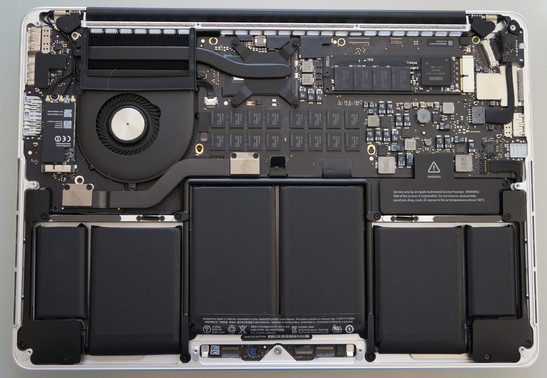
The integrated 720p FaceTime Hard disk drive webcam is still one of the drawbacks. The performance is average for video calls, merely we certainly look more from Apple considering of their emphasis on iMessage and video calls. The voice quality on the other hand was first-class cheers to the two microphones.
Keyboard
The fantabulous chiclet keyboard with groundwork illumination remained unchanged. Haptics, feedback and key size are nifty and we managed the aforementioned typing speed equally with a mechanical Cherry MX 3000 (86 words per minute) right away. One small drawback is the minimalistic lettering ("Where is the damn tilde?") and especially Windows users volition take some problems because of the different primal assignments (@,{}.[]).
Touchpad
Apple's multi-affect glass touchpad is still the benchmark. The combination of a smooth glass surface, user-friendly pressure point, precise execution and smart drivers under Os X is more or less unrivaled in the Windows globe. Hither we can see the result of the shut relationship betwixt software and hardware. Scrolling, zooming and swiping work flawlessly and without whatsoever credible bug. The only drawback is the sharp edge at the forepart of the touchpad.
Afterward one week, we also encountered keyboard and trackpad issues. The problem is therefore quite rare, simply the resulting waiting period of around one minute in stand-by is rather annoying.
The glossy xiii-inch display has a resolution of 2560x1600 pixels in the already disappearing sixteen:10 ratio. The bodily screen infinite matches the 1280x800 resolution with the standard settings, merely texts and icons are obviously much sharper (with Retina-ready apps). The apparent advantage of this solution is that even old applications tin be used without adjustments; they simply don't look as nice. This is a big problem nether Windows with its DPI scaling. Our tests with Boot Camp oft revealed very minor and hardly readable texts (older 3D Mark or X-Rite software) and overlapping elements (check boxes in Fraps). You can also select up to 1680x1050 pixels (scaled) - with minimal loss of quality (not every bit bad as the wrong resolution, for instance).
Unfortunately, nosotros saw some fluctuations with our brightness measurements since Windows 8.1 still has some issues with the brightness sensor. The results in OS Ten were slightly amend than the results in Windows with a maximum brightness of 388 cd/m² and a blackness value of 0.iv cd/1000². The contrast ratio of 970:1 is very adept and our subjective impression of the display is also very skillful.
| 329 cd/m² | 316 cd/k² | 317 cd/chiliad² | ||
| 368 cd/m² | 360 cd/m² | 337 cd/thou² | ||
| 314 cd/1000² | 338 cd/one thousand² | 298 cd/m² | ||
Distribution of effulgence
APPA020
10-Rite i1Pro ii
Maximum: 368 cd/m² (Nits) Average: 330.8 cd/m²
Effulgence Distribution: 81 %
Heart on Battery: 360 cd/one thousand²
Dissimilarity: 900:1 (Black: 0.4 cd/yard²)
ΔE Colour 1.87 | 0.59-29.43 Ø5.three
ΔE Greyscale 2.xix | 0.64-98 Ø5.6
63% AdobeRGB 1998 (Argyll 1.half dozen.3 3D)
Gamma: 2.58
| 297 cd/g² | 290 cd/m² | 294 cd/m² | ||
| 327 cd/m² | 327 cd/m² | 304 cd/m² | ||
| 285 cd/m² | 305 cd/k² | 275 cd/m² | ||
Distribution of brightness
APPA020
Gossen Mavo-Monitor
Maximum: 327 cd/m² (Nits) Boilerplate: 300.four cd/yard²
Brightness Distribution: 84 %
Heart on Bombardment: 327 cd/m²
Contrast: 779:1 (Black: 0.42 cd/thousand²)
The color accurateness of our review unit of measurement is excellent, fifty-fifty without a calibration. The DeltaE deviations in the ColorChecker test are the lowest we ever measured. Therefore, the human eye should not run into any differences between the displayed and the real color. Results for the grayscale presentation are not equally good, but our i1Pro ii measuring tool is less accurate at lower brightness settings. The sRGB colour infinite is completely covered by the Retina brandish.
Some of the post-obit measurements were only taken in Windows 8.1 since the 10-Rite software did not recognize our i1Pro 2 in Os 10 (this is also the reason for the brightness differences betwixt nautical chart and text).
A calibration with the X-Rite software improves the results fifty-fifty farther, and so the brandish should be well suited for demanding picture editing.
Thanks to the high maximum brightness, you tin can use the device outdoors, despite the glossy brandish surface. Reflections are too reduced by a ruby hue; it seems that Apple tree uses some kind of anti-reflective coating. Compared to the old MacBook Pro thirteen there is no more protective drinking glass cover, and there are no more double reflections as a result.
Thank you to the IPS display in that location are no color distortions, even with extreme viewing angles. The motion picture does not endure from a reduced dissimilarity every bit fast every bit the Schenker S413, however, the reflections of the Apple device can exist very annoying.
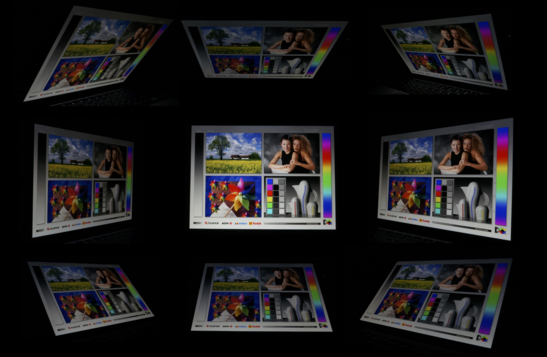
Display Response Times
ℹ
Display response times bear witness how fast the screen is able to change from one color to the next. Tedious response times can pb to afterimages and can cause moving objects to announced blurry (ghosting). Gamers of fast-paced 3D titles should pay special attending to fast response times.
| ↔ Response Time Black to White | ||
|---|---|---|
| 26.2 ms ... ascent ↗ and fall ↘ combined | ↗ 5.ii ms ascent | |
| ↘ 21 ms fall | ||
| The screen shows relatively slow response rates in our tests and may exist besides dull for gamers. In comparison, all tested devices range from 0.iv (minimum) to 240 (maximum) ms. » 56 % of all devices are better. This means that the measured response time is worse than the average of all tested devices (23.2 ms). | ||
| ↔ Response Time l% Grey to fourscore% Grey | ||
| 33 ms ... ascension ↗ and autumn ↘ combined | ↗ 15 ms rise | |
| ↘ xviii ms autumn | ||
| The screen shows slow response rates in our tests and will be unsatisfactory for gamers. In comparison, all tested devices range from 0.25 (minimum) to 636 (maximum) ms. » 31 % of all devices are better. This means that the measured response time is similar to the average of all tested devices (36.5 ms). | ||
Screen Flickering / PWM (Pulse-Width Modulation)
ℹ
To dim the screen, some notebooks will just wheel the backlight on and off in rapid succession - a method chosen Pulse Width Modulation (PWM) . This cycling frequency should ideally be undetectable to the man eye. If said frequency is too low, users with sensitive eyes may experience strain or headaches or even observe the flickering altogether.
| Screen flickering / PWM not detected | ||
| In comparison: 52 % of all tested devices do not use PWM to dim the display. If PWM was detected, an average of 19996 (minimum: 5 - maximum: 3846000) Hz was measured. | ||
The Boot Army camp installation was not trivial in our examination. Nosotros also had the problem that we could non install Windows right away (see Apple Discussions). We were finally successful with a Win 8.1 Trial (via ISO) on a new USB stick. The driver support is still far from perfect, the touchpad, for example, does not support Windows eight gestures and the effulgence command did not work properly. Finally, the resolution scaling in Windows cannot keep up with Os X, merely this is not only a problem of the MacBook.
Intel significantly improved the operation of the integrated GPU with the Haswell generation. These are perfect conditions, especially for the MacBook Pro xiii Retina. The former version from 2012 suffered from the weak Hard disk Graphics 4000 of the Ivy Bridge compages and the situation is much ameliorate in the current Retina version. Websites and applications were very polish in our tests.
System information Apple MacBook Pro Retina 13 Late 2013
The integrated Cadre i5-4258U merely has an reward of 4-nine% over the Cadre i5-3210M from 2012. The Zenbook UX301 with the i7-4558U, which is also available for the Retina, has an advantage of more than 10% on average.
A comparing betwixt Windows eight.1 and Bone 10 Mavericks favors Windows in all of our Cinebench versions, except for CB 10 (even though the 64-scrap version is still faster nether Windows).
Cinebench R10 Rendering Single 32Bit
4831
Cinebench R10 Shading 32Bit
6612
Cinebench R10 Rendering Multiple CPUs 32Bit
10604
Cinebench R11.5 OpenGL 64Bit
22.44 fps
Cinebench R11.5 CPU Multi 64Bit
2.92 Points
Cinebench R11.5 CPU Unmarried 64Bit
1.21 Points
Cinebench R15 Ref. Match 64Bit
99.iii %
Cinebench R15 OpenGL 64Bit
twenty.77 fps
Cinebench R15 CPU Multi 64Bit
261 Points
Cinebench R15 CPU Unmarried 64Bit
112 Points
Help
Thanks to the fast SSD and the powerful mainstream Haswell CPU, the PCMark result of the Retina MacBook Pro xiii is very good. Information technology is basically on the same level with the 2012 Retina MacBook Pro 15 with dedicated graphics.
| PCMark seven Score | 5460 points | |
| PCMark 8 Home Score Accelerated | 3112 points | |
| PCMark 8 Creative Score Accelerated | 3297 points | |
| PCMark 8 Piece of work Score Accelerated | 3681 points | |
| Aid | ||
| PCMark 7 - Score (sort by value) | |
| Apple MacBook Pro Retina thirteen inch 2013-10 | |
| Apple MacBook Air xi inch 2013-06 1.7 GHz 256 GB | |
| Apple MacBook Air 13 inch 2013 MD760D/A | |
| Apple MacBook Air 11 inch 2013-06 MD711D/A | |
| Apple MacBook Pro Retina 13 inch 2012-10 | |
| Apple MacBook Pro Retina 15 inch 2012-06 | |
| Asus Zenbook UX301 | |
| Sony Vaio Pro 13 SVP-1321C5ER | |
| Lenovo ThinkPad T440s 20AQ-S00500 | |
Legend
Apple MacBook Pro Retina xiii inch 2013-10 Intel Core i5-4258U, Intel Iris Graphics 5100, Apple SSD SM0256F
Asus Zenbook UX301 Intel Core i7-4558U, Intel Iris Graphics 5100, 2x Sandisk X110 SD6SP1M-128G RAID 0
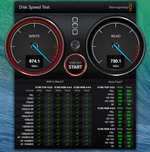
Like to the Haswell based MacBook Airs, Apple also equips the new Retina MacBook Pro 13 with a PCIe SSD. It provides significantly higher sequential transfer rates than single SSDs via SATA. This solution tin can fifty-fifty compete with larger and vulnerable RAID 0 configurations that tin can be found in the Asus Zenbook Infinity UX301LA, for example. The Apple SSD with the designation SM0256F uses a controller (S4LNO53X01-8030) and memory chips (K9HFGY8S5C-XCK0) from Samsung.
The Equally SSD overall score shows that the Samsung SSD does not accept to hide behind 2 SanDisk X110s (RAID 0) in the Zenbook UX301. The RAID configuration only managed a 16% higher score and simply reached between 58% and 94% of the performance in the re-create criterion. A quick look at the results shows that Apple's solution is especially fast in sequential operations. Single 4K operations are however not the strong suit of the bulldoze.
Despite this 4K problem, the Samsung SSD shows very good results in the Tracing benchmarks of PCMark 7 and 8 and can take a peak spot in our charts.

Sequential Read: 705 MB/s
Sequential Write: 634 MB/southward
Sequential Write: 592MB/southward
Admission Time Write: 0.17ms
The integrated Intel Iris Graphics 5100 is the GT3 version of the Haswell GPU with all shaders, only without the dedicated retention from the Iris Pro 5200. The clock is dynamically adapted between 200 and 1100 MHz via Turbo Boost. By the way, the Core i7 tin can use another 100 MHz with a maximum clock of 1200 MHz, which should result in a theoretical performance advantage with sufficient cooling.
Constructed benchmarks nether Windows 8.ane prove the functioning of the new GPU. The advantage over the HD 4400 (GT2), which is used in many ultrabooks, is impressive. Near review units only manage 70% of the functioning and the difference to the old MBP Retina with Intel HD Graphics 4000 is huge. The 2012 Retina only managed 47% of the HD 5100'south performance in the 3DMark eleven GPU Test for instance, however, 3DMark eleven is not really affected by memory bandwidth. The HD Graphics 5000 in the MacBook Air is based on the same core with lower clocks; the difference in 3DMark 2013 and xi is merely around five%.
| 3DMark eleven - 1280x720 Performance GPU (sort by value) | |
| Apple MacBook Pro Retina 13 inch 2013-10 | |
| Apple MacBook Air 11 inch 2013-06 one.seven GHz 256 GB | |
| Apple MacBook Air 13 inch 2013 MD760D/A | |
| Apple MacBook Air 11 inch 2013-06 MD711D/A | |
| Apple MacBook Pro Retina thirteen inch 2012-10 | |
| Apple MacBook Pro Retina fifteen inch 2012-06 | |
| Asus Zenbook UX301 | |
| Sony Vaio Pro thirteen SVP-1321C5ER | |
| Lenovo ThinkPad T440s 20AQ-S00500 | |
| 3DMark 06 Standard Score | 7474 points | |
| 3DMark 11 Performance | 1270 points | |
| 3DMark Ice Storm Standard Score | 39510 points | |
| 3DMark Cloud Gate Standard Score | 5286 points | |
| 3DMark Fire Strike Score | 863 points | |
| Help | ||
The immediate rival when it comes to gaming performance nether Windows is the Asus UX301, which was equipped with the more powerful Cadre i7-4558U and the same Iris Graphics 5100 in our review configuration. However, the i7 has a 100 MHz higher GPU clock with Turbo Heave. The gaming benchmarks show mixed results; the Asus was around 5-ten% faster inFIFA andCompany of Heroes ii, just likewise 5% slower inTomb Raider andTotal War: Rome II. These results can be affected past cooling, drivers, game patches since our review of the Asus or measuring tolerances. Generally speaking, the gaming performance in Windows is comparable.
Our criterion site of the Iris Graphics 5100 shows that current games are normally only playable with lowest details.
We also tested two games in Bone X Mavericks (via Steam). Left 4 Dead ii was not completely polish with 19 fps at 2560x1600 (maximum details), merely a reduced resolution of 1280x800 improved the situation. Even Civilisation V was playable and looked quite nice at 1280x800 with default settings (Medium / Low).
The Core i5-4258U has an integrated hardware decoder for H.264, WMV and VC-ane for videos with a resolution of up to 4K. Apple has unfortunately only used the decoder for H.264 in Bone 10. Nonetheless, it worked flawlessly in our examination. A 4K 100 Mbps H.264 sample video only results in minimal CPU load and we could not run across any problems during playback. A 1080p H.264 video showed a similar CPU load, which confirms the use of the hardware decoder.
YouTube Flash videos were no problem for the MacBook Pro Retina, either. Even a 4K video did non testify any dropped frames and CPU load was quite low.
VC-i and WMV are not supported by the standard video player, so we installed the free VLC Role player. Playback of 1080p videos in WEBM, WMV and VC-1 produced more than CPU load but the playback was smooth. The 4K sample video on the other paw showed the limits of the CPU (full load, jerky playback), which is a sign of missing hardware support.
By the way, you can employ the hardware decoder via DXVA-Hooks under Windows 8.i (via Kicking Camp) without restrictions.
System Dissonance
Reverse to the sometime version, Apple simply uses a unmarried fan for the new 13-inch Retina. It can convince u.s. with the silent operation; the fan works with inaudible 1200-1300 rpm according to smcFanControl. Our measurement tool cannot differentiate between the device and the ambience dissonance from a altitude of 15 cm (27.3 dB / 0.93 sone). Lite workloads did not increase the fan speed, even a 4K video, a YouTube 1080p video and several browser tabs did not alter the situation.
We could only see higher speeds nether load. A loop of Cinebench R15 Multicore Tests resulted in 1900 rpm at 27.5 dB(A) / 0.95 sone. This is but slightly aural if you lot put your ear right next to the fan exhaust.
Unigine Heaven Valley 1.0 with Ultra settings resulted in an aural fan noise at 4200 rpm with 36.2 dB(A) and 2.45 sone; nonetheless comparatively good results. The system racket is dominated by the air noise, which is very convenient. The maximum system noise under Mac OS X was 42.4 dB(A) / 4 sone with Unigine Valley and Cinebench R15 simultaneously.
The fan speeds during normal workloads are subjectively much higher under Windows 8.ane. 3DMark 06 (encounter chart further beneath) even shows a maximum of 42.5 dB(A) (and therefore more than the maximum under Mac OS X). The noise leveled off at a clearly audible 44.five dB(A) / 4.vi sone duringFIFA 14, only the dissonance feature was nonetheless pleasant.
Our usual stress test with Prime95 and FurMark resulted in 5800 rpm and a loud 44.vii dB(A) / four.8 sone. Withal, we could not reach the maximum fan speed (6199 rpm with 47.ix dB(A) and 5.9 sone) with an ambient temperature of 22 °C (71.6 °F). This ways at that place is still some thermal headroom for hot summer days.
Overall, we are really convinced by the noise development of the 13-inch Retina MacBook Pro. The device is usually silent in most scenarios without GPU load under Mac Bone 10. More load leads to an acceptable noise without a pulsating fan.
Dissonance Level
| Idle | 27.4 / 27.four / 27.iv dB(A) | |
| HDD | 27.iv dB(A) | |
| Load | 42.five / 44.7 dB(A) | |
 | ||
| 30 dB 40 dB(A) 50 dB(A) | ||
| min: | ||
A low fan speed combined with an aluminum case is usually a problem for the temperatures. Apple is also known for accepting higher temperatures.
However, light workloads (for example idle or web browsing) are no problem at all. The whole instance remains conveniently absurd in our test. Compared to the predecessor, our measurements are slightly lower and most of the reviewed subnotebooks cannot go along up with the new Retina either.
The temperatures are still reasonable under load. Especially the important palm residual stays very absurd in all situations. The Haswell notebook shows an comeback over its predecessor and tin can too beat the average consequence of the other subnotebooks.
The hot spot is once once more around the fan exhaust at the correct area above the keyboard.
The internal temperatures likewise prove the dissimilar fan controls of Windows 8.1 and Bone 10 Mavericks. While the CPU only reached upward to 85 °C (185 °F) in our stress test under Windows, we could determine temperatures of up to 93 °C (199.iv °F) for the Core i5 with OS 10, particularly during gaming.
Throttling was however no problem, neither with Windows nor with Os X. Despite the inaudible fan, fifty-fifty the 13th run of Cinebench R15 Multi shows the expected result (no subtract in performance, 1.5% margin of fluctuation for the results). HWInfo64 nether Windows nonetheless indicated a core clock of 2.3 GHz after ane hour of maximum load, and a following benchmark showed the expected results.
| |||||||||||||||||||||||||
| Maximum: 43 °C = 109 F Average: 35.3 °C = 96 F | |||||||||||||||||||||||||
| |||||||||||||||||||||||||
| Maximum: forty °C = 104 F Average: 34.eight °C = 95 F | |||||||||||||||||||||||||
Ability Supply (max.) 56 °C = 133 F | Room Temperature 21.8 °C = 71 F | Fluke 62 Mini
| |||||||||||||||||||||||||
| Maximum: 29 °C = 84 F Average: 28 °C = 82 F | |||||||||||||||||||||||||
| |||||||||||||||||||||||||
| Maximum: 28 °C = 82 F Average: 27.1 °C = 81 F | |||||||||||||||||||||||||
Power Supply (max.) 39 °C = 102 F | Room Temperature 22 °C = 72 F | Fluke 62 Mini
(±) The average temperature for the upper side under maximal load is 35.iii °C / 96 F, compared to the average of 30.vii °C / 87 F for the devices in the class Subnotebook.
(±) The maximum temperature on the upper side is 43 °C / 109 F, compared to the average of 35.8 °C / 96 F, ranging from 21.4 to 58.four °C for the class Subnotebook.
(±) The bottom heats up to a maximum of xl °C / 104 F, compared to the boilerplate of 39.5 °C / 103 F
(+) In idle usage, the average temperature for the upper side is 28 °C / 82 F, compared to the device average of 30.seven °C / 87 F.
(+) The palmrests and touchpad are cooler than skin temperature with a maximum of thirty °C / 86 F and are therefore cool to the bear upon.
(±) The boilerplate temperature of the palmrest area of similar devices was 28.3 °C / 82.9 F (-1.7 °C / -three.one F).
The integrated speakers are very loud with upwards to 80 dB(A) / 44.iv sone. Due to their size, they manifestly lack bass, but the overall sound experience is sufficient for occasional music playback.
The sound arrangement is likewise significantly better than the erstwhile MBP 13 with a Core 2 Duo two.four GHz. Information technology is louder (36 vs. 44 sone) and produces a richer sound feel. The Logitech speaker Lapdesk is similarly loud with 41 sone, merely produces more bass and therefore a better sound.
The integrated headset port had no problems with high-impedance AKG K701 headphones; volume was sufficient and nosotros could not determine whatsoever background noises.
Power Consumption
Compared to the subnotebook class average we can run into that new Retina is more than frugal during idle. The minimum consumption is only beaten by the MacBook Air 11 and the Sony Vaio Pro 13. We tin can however come across the effects of the powerful CPU and GPU under load, where the Retina can be found at the bottom of the charts side by side to subnotebooks with a dedicated GPU like the Samsung Ultra Bear on 740U3E or the Satellite L840-15L.
A full recharge of the MBP13 took around two hours with light utilise and 60% of the capacity was available after merely 54 minutes.
Battery runtimes are certainly a highlight of the MacBook Pro Retina 13. Despite the powerful Core i5 CPU, the Apple tree device is amongst the best subnotebooks during idle and in the WLAN Test. Only load shows the high consumption of the powerful hardware. Only yous also get the full performance on battery in return, while many competitors are artificially throttled by the manufacturer.
Os X Mavericks comes standard without Flash Player. Without it, the Retina managed 51 minutes more in our WLAN Test (YouTube video playback with HTML v, Flash advertisements were missing) than with the installed Flash Player.
A comparison with the subnotebook competition shows that the Apple tree product has a big reward in the WLAN scenario. The Retina is simply beaten by the 11-inch and 13-inch MacBook Air and far ahead of the adjacent notebooks in line, the ThinkPad Edge E145 with a slower E1-2500 and so the EliteBook Folio 9470M.
Battery Runtime
| Idle (without WLAN, min brightness) | 25h 35min | |
| WiFi Surfing | 9h 29min | |
| Big Buck Bunny H.264 1080p | 7h 47min | |
| Load (maximum effulgence) | 1h 39min |
| Battery Runtime - WiFi (sort past value) | |
| Apple tree MacBook Pro Retina 13 inch 2013-x | |
| Apple tree MacBook Air 11 inch 2013-06 ane.seven GHz 256 GB | |
| Apple MacBook Air 13 inch 2013 MD760D/A | |
| Apple tree MacBook Pro Retina 13 inch 2012-10 | |
| Apple MacBook Pro Retina fifteen inch 2012-06 | |
| Asus Zenbook UX301 | |
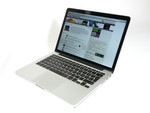
The MacBook Pro 13 with Retina Display is an first-class notebook. Compared to the predecessor information technology is now thinner and lighter with meliorate performance and longer battery runtimes. Case, input devices, emissions and the screen are still the benchmark in many respects. However, there are likewise some drawbacks. Our test showed the average WLAN performance and especially the maintainability and reparability are a big problem. We also did not like the poor Windows support via Boot Army camp.
The biggest competitor is obviously Apple's MacBook Air 13. It offers slightly more screen surface area with 1440x900 pixels compared to the "Best (Retina)" resolution. The resolution scaling of the Retina even so works really well, so this is not a serious drawback. This leaves the lower weight against the better performance and the much improve display.
Asus' Zenbook Infinity UX301LA, with similar hardware equipment, is the biggest competitor when looking at Windows devices. It is slightly lighter, just has shorter bombardment runtimes in return. Other high-resolution notebooks like Lenovo's Yoga 2 Pro should also arrive shortly. Equally ultrabooks, these devices as well offering a touchscreen and can sometimes (in the case of the Yoga) even be used every bit a tablet.
Thanks to the cost cut past Apple, the MacBook Pro is surprisingly competitive in comparison. With similar specs, the Core i7 version of the MBP 13, for instance, is currently cheaper than a Zenbook Infinity UX301 and fifty-fifty a Yoga 2 Pro is currently but slightly less expensive because of the weaker processor.
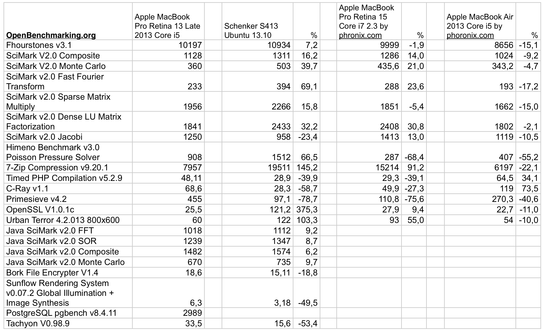

I am one of the founders of Notebookcheck. My primary focus is on articles about new CPU and GPU applied science. With my scientific background (Ph.D. in informatics) I try to put facts before feelings in my work. I have been writing and working for Notebookcheck since 2005.

I grew up with modern consumer electronics and my first computer was a Commodore C64, which encouraged my interest in edifice my ain systems. I started working as a review editor for Notebookcheck during my dual studies at Siemens. Currently, I am mainly responsible for dealing with business laptops and mobile workstations. Information technology's a great experience to exist able to review the latest devices and technologies and then compare them with each other.

Specifications
Memory
8192 MB
, DDR3L 800MHz 11-11-11-28 Dual-Aqueduct
Display
xiii.thirty inch 16:10, 2560 x 1440 pixel, APPA020, IPS, sleeky: aye
Mainboard
Intel Lynx Bespeak-LP
Storage
Apple SSD SM0256F, 256 GB
, UXM2JA1Q, PCIe, 232 GB free
Soundcard
Intel Lynx Point-LP - High Definition Audio Controller
Connections
ii USB three.0 / 3.1 Gen1, ii Thunderbolt, i HDMI, two DisplayPort, Audio Connections: Headset port (digital/analog), Card Reader: SD card, Sensors: Ambient Calorie-free
Networking
Broadcom 802.11ac (a/b/g/n = Wi-Fi iv/ac = Wi-Fi 5), Bluetooth 4.0
Size
height x width x depth (in mm): eighteen ten 314 x 219 ( = 0.71 ten 12.36 10 viii.62 in)
Battery
72 Wh Lithium-Polymer, Battery runtime (according to manufacturer): 540 h
Operating System
Apple OS X ten.ix Mavericks
Photographic camera
Webcam: 720p FaceTime Hard disk
Additional features
Speakers: Stereo, Keyboard: Chiclet, Keyboard Light: yes, Microfiber cloth, iLife
Weight
1.563 kg ( = 55.13 oz / iii.45 pounds), Power Supply: 247 chiliad ( = 8.71 oz / 0.54 pounds)
Devices from a unlike Manufacturer and/or with a unlike CPU
Devices with Aforementioned Screen Size and/or Weight
- Tips for buying a notebook - notebookCHECK Purchase Advisory
- Find the right notebook - notebookCHECK Hardware Guide
- Display resolution comparison - DPI (grain size) of displays
- Our test criteria
- Manufacturer's information
Pros | |
| + | Very repose |
| + | Long battery runtimes |
| + | Splendid unibody chassis |
| + | High-resolution IPS display with splendid OS back up |
| + | Bully input devices |
Cons | |
| - | Nigh no upgradeability |
| - | Difficult to maintain and to repair considering of pentalobe screws |
| - | Glossy display |
| - | Only 12 months warranty and expensive upgrade to 3 years |
Apple MacBook Pro Retina xiii inch 2013-x - 2014-06-27 06/27/2014 v4(quondam)
Klaus Hinum
Subnotebook - Weighted Boilerplate
Klaus Hinum, 2013-11- v (Update: 2021-05-18)
Source: https://www.notebookcheck.net/Review-Apple-MacBook-Pro-Retina-13-Late-2013-Notebook.105035.0.html
Posted by: solistheaks.blogspot.com

0 Response to "Macbook Pro 13 Late 2013 Test"
Post a Comment